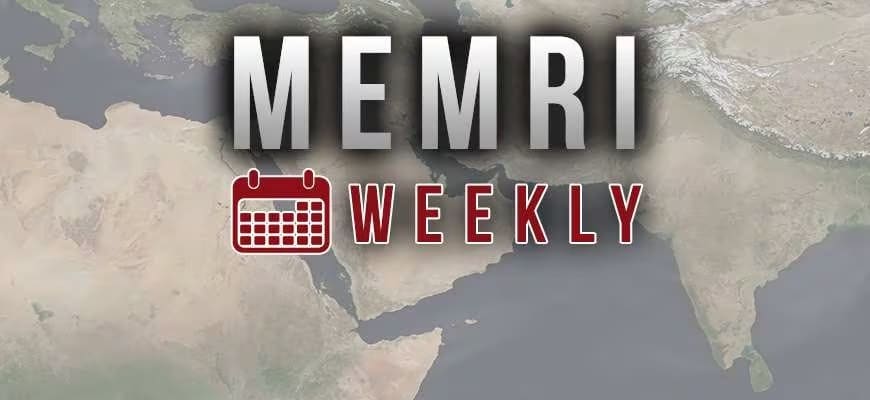At a Capitol Hill briefing on June 6, 2007, Senior Analyst of MEMRI's Middle East Economic Studies Program, Dr. Nimrod Raphaeli addressed staff of the Senate Foreign Relations Committee on water poverty and potential water conflicts in the Middle East.
Dr. Raphaeli will be the editor of MEMRI's upcoming Economic Blog. The blog will provide its readers with economic news from the Middle East as well as analysis of major developments and trends.
The following is the paper Dr. Raphaeli presented at the briefing:
Introduction
This briefing comprises two parts: part one offers an introduction to the water poverty in the Middle East, part two focuses on three potential areas of conflict:[1]
Part One: Water Poverty in the Middle East
There are common issues regarding water scarcity in the Middle East:
· The Middle East is the world’s most-water stressed region. Most of the region’s countries cannot meet current water demand.
· The average availability of water is 1200 cm [cubic meters] per person per year, projected to be halved by 2050 (This compares to a global average of 8,900 cm per person per year today and about 6,000 cm per person per year in 2050.
· Aquifers are over-pumped and water quality is deteriorating, with consequences for human health, agricultural productivity, and the environment.
· Unreliable water services are prompting people to migrate in search of better opportunities.
· About 60% of the region’s water is transboundary i.e., water which flows across international borders, leaving a number of countries, including Egypt, Iraq and Syria, to be affected by decisions made upstream by riparian countries. The Dependency Ratio - i.e., the share of the total renewable water resources originating outside the country: Egypt 96.9%; Syria 80.3%; Iraq 53.3%, and Jordan 22.7%. Hence, agreements on water allocation are crucial.
· The Middle East has the highest percent of total renewable water resources withdrawal (about 75 percent). Distant second is South Asia with 25 percent and the lowest is Latin America and the Caribbean at about 2 percent.
Water - A Strategic Commodity
Like oil, water is a strategic commodity with a surplus in some countries and a deficit in others. Also like oil, water is not distributed equitably. Canada, for example, with a population of 31 million, or 0.5% of world population, controls 2,850 bcm [billion cubic meters] of fresh water, or 2.5 percent of the world total, which is the equivalent of the Chinese reserve with a population 40 fold that of Canada. The sale or transfer of surplus water in a systematic and organized fashion, preferably under some sort of an international convention may become necessary. However, unlike that of oil, a transfer of water whether on high seas or over land will not be a serious cause of pollution.
Depletion of Ground Water
To meet the increasing demand, groundwater, the main source of water in many countries, is being extracted well beyond the renewable rate of the resources. In some cases, governments are tapping into the fossil groundwater resources and, where feasible, have initiated seawater desalination projects [See Appendix]. Degraded water quality further reduces the availability of freshwater suitable for domestic and agriculture use and increases the cost of treatment and reuse of water.
Environmental Cost of Water Degradation
Increased water contamination due to inadequate treatment is costly in terms of public health, child mortality, communicable diseases, salinization of agricultural land and reduced fish catch. These factors, according to the World Bank study, are valued between 0.5 of GDP in some countries to as high as 2.5 percent of GDP in other countries.
Part Two: Potential Areas of Conflict
In the Middle East there are three areas of potential conflict:
a. The Nile River Basin
b. The Euphrates and Tigris Rivers Basin
c. The Jordan River and the Israeli-Palestinian Use of Water Resources
At the center of the Middle East’s agenda on water are four far-flung river basins with names famous for millennia - the Nile, the Euphrates and Tigris, and the Jordan. The four rivers supply the Middle East with most of its fresh surface water. The river basins vary considerably from each other. Their problems are distinct and therefore require different solutions and approaches.
A. The Nile Basin
The Nile River is the longest river in the world. From its major source, Lake Victoria in east central Africa, the White Nile flows generally north through Uganda and into Sudan where it meets in Khartoum the Blue Nile which rises in the Ethiopian Highlands. The Nile traverses 4,169 miles from Africa to its delta in Egypt on the Mediterranean Sea.
SUPPORT OUR WORK

The Nile is shared by ten countries - Burundi, Democratic Republic of Congo, Egypt, Eritrea, Ethiopia, Kenya, Rwanda, Sudan, Tanzania and Uganda - with a combined population of about 160-170 million who live within the boundaries of the Nile Basin. Over 300 million people are projected to live there in 25 years.
The Nile Water Agreement (NWA) of 1929
The Nile Water Agreement between Great Britain, representing its colonies in East Africa, and Egypt was signed in November 1929. The agreement allocated 48 billion cubic meters of water per year to Egypt as its acquired right and 4 billion cubic meters per year to Sudan. These allocations were later increased to 55.5 bcm and 18 bcm, respectively to Egypt and Sudan in accordance with a bilateral agreement between the two countries that allowed for the construction of the Aswan Dam.
Population pressures, frequent draughts, and increasing soil salinity have intensified the demands by the Nile Basin countries to renegotiate the 1929 agreement. Egypt has so far refused. However, the 1959 agreement between Egypt and Sudan, which increased the water allocations to themselves while completely ignoring the interests of the other riparian countries such as Tanzania, Kenya and Ethiopia has, in retrospect, weakened the Egyptian argument about the inviolability of the NWA.
Response to Pressures
It is almost inevitable that the Nile Basin riparian countries will have to use more of the Nile to provide drinking water to, and feed, a growing population. Egypt will have to settle reluctantly for less water than what was provided by the NWA. For one thing, Egypt will have to reduce waste through an improved irrigation system. According to a 2003 study by the World Bank, 94.4 percent of the economically active population of Egypt is engaged in agriculture which has consumed 88 percent of water resources but contributed only 14 percent to GDP. The report suggests that "from a narrow macroeconomic perspective, rationale of justifying the allocation of water to agriculture over industrial and other sectors is weak." This is quite typical for the rest of the Middle East. Dr. Khalid abu-Zeid, the regional director of the Water Resources Program in the Center for Environment and Growth for Arab-European Region, estimated that agriculture in the Middle East utilizes 86 percent of all water resources leaving only 14 percent for personal consumption, industry and other uses.[2]
The Nile Basin Initiative
The Nile Basin Initiative (NBI) is regarded as a regional partnership within which the countries of the Nile Basin have united in common pursuit of the sustainable development and management of Nile waters. "It provides an institutional framework to promote cooperation built on strong riparian ownership and shared purpose and supported by the international community."
In assessing the initiative, the World Bank, which took a leading role in putting together the NBI, commented:
The Nile waters embody both potential for conflict and potential for mutual gain. Unilateral water development strategies in the basin could lead to serious degradation of the river system and result in greatly increased tensions among riparians. Conversely, cooperative development and management of Nile waters in sustainable ways could increase total river flows and economic benefits, generating opportunities for "win-win" gains that can be shared by the raparians.[3]
B. The Euphrates and Tigris Rivers Basins
The land known today as Iraq was in ancient times called Mesopotamia or the land of the two rivers - a reference to the two great rivers, the Euphrates and the Tigris, which have supplied Iraq with water forever. Today the Euphrates River is shared by Turkey, Syria and Iraq while the Tigris is shared between Turkey and Iraq.
There are new sources of conflict in the horizon. Turkey is engaged in an ambitious project known by its Turkish acronym "GAP." (In some Arab quarters it is referred to derogatively as "mashru’ al-Ghab" or the jungle project.)[4] Under the GAP, Turkey plans to build 21 dams by 2023, 13 dams on the Euphrates and 8 dams on the Tigris. It has thus far completed 5 on the Euphrates and only one on the Tigris. It also plans to divert water through tunnels to southeastern Turkey, where as many as 2 million hectares of land will be irrigated. The project, when completed, will produce 47 billion KW of electricity annually.
Syria and Iraq allege that (a) Turkey has failed to consult with them in advance of its plans; (b) Turkey’s hydro projects reduce the amount of water flowing into their countries; and (c) Turkey is releasing polluted water across the frontier; at a minimum it is releasing water without silt which is a natural fertilizer.
Turkey has rejected claims by its two neighbors - Syria and Iraq. As early as the 1950s, Turkey’s President Suleyman Demirel declared that: "Neither Syria nor Iraq can lay claim to Turkey’s rivers any more than Ankara could claim their oil. This is a matter of sovereignty…The water resources are Turkey’s, the oil resources are theirs. We don’t say we share their oil resources and they cannot say they share our water resources."[5]
This view is no longer binding from an international law perspective. Article 7 of the 1997 UN Convention on "Watercourse Convention and the Euphrates and Tigris Rivers" stipulates,
Watercourse States shall, in utilizing an international watercourse in their Territories, take all appropriate measures to prevent the causing of Significant Harm to other watercourse states.
The conflict between Iraq and Turkey on the issue of water is complicated by the activities of the PKK-led Kurdish uprising in Turkey itself, and inclination of the Turkish regime to accuse the Kurdish autonomous region in northern Iraq of giving shelter to the PKK. Apart from the disagreement with Iraq and Syria, the fact that Turkey’s massive water projects are located in areas heavily populated by the Kurdish minority could, in itself, become another source of conflict.
Iraq has also accused Syria of building large water projects on the Euphrates which further harm the interests of Iraq in terms of the quantity and quality of water flowing downstream. As a result of the dams on the Euphrates, the volume of water flowing into Iraq has decreased from 28 bcm [billion cubic meters] to 10-12 bcm and the quality of water has deteriorated considerably due to increasing salinity.[6] A study by the UN Food and Agricultural Organization found that 74% of the irrigated land in central and southern Iraq suffers from salinity.
C. The Jordan River
The Jordan River flows between four countries, two of which, Jordan and Israel, have a peace treaty that regulates the use of the river basin and its tributary. The other two countries, Syria and Lebanon, are contentious riparian countries. Of Israel’s neighbors, only Jordan can claim a lower water potential.
Annex II of the Jordan Israel Peace Treaty addresses the issues of water allocation of the Jordan Rivers and its main tributary, the Yarmuk River. Under Article III of the Annex, titled "Water Quality and Protection,"
Jordan and Israel each undertake to protect, within their own jurisdiction, the shared waters of the Jordan and Yarmouk, and Araba/Arava groundwater, against any pollution, contamination, harm or unauthorized withdrawals of each other’s allocation. (III.1)
Other provisions of Article III call for a joint monitoring of the quality of water and the prohibition on the disposal of municipal and industrial wastewater into the courses of the Yarmouk and the Jordan Rivers "before they are treated to standards allowing their unrestricted agricultural use."
In fact, the Jordan River is being contaminated with raw sewage, particularly in the 60-mile downstream stretch from the Sea of Galilee to the Dead Sea. The practice has almost destroyed the river’s ecosystem. Rescuing the river could take decades.
Israel and the Palestinians
The limited surface resources have led to widespread scarcity of the fresh water resources, resulting in a heavy reliance on groundwater as the major source for various uses. The contribution of surface water to the overall water balance is limited and marginal. "Nowhere are the problems of water governance as starkly demonstrated as in the Occupied Palestinian Territories." According to the UNDP report, "Palestinians experience one of the highest levels of water scarcity in the world." This scarcity is attributed to physical scarcity and political governance.
The report estimates that, on a per capita basis, people living in the Occupied Palestinian Territories have access to 320 cubic meters of water annually, "one of the lowest levels of water availability in the world and well below the threshold of absolute scarcity." The Israeli population, which is about twice the size of the Palestinian population, uses seven and a half times the amount of water used by the Palestinians. The discrepancy in the use of water has to do with politics as well as with life style, the ratio of urban population and the levels of economic development.
Any future settlement between Israel and the Palestinians must address the issue of water. The UNDP report recommends the 1994 peace agreement between Israel and Jordan as a model for Israel and the Palestinians. The agreement allows Jordan to store winter waters in Lake Tiberias [Lake Kinneret]; at the same time, it allows Israel to use, on a rental basis, a number of water wells in Jordan to irrigate Israeli agriculture.
The report also refers to a regional initiative for regional cooperation. The Middle East Desalinization Research Center, based in Muscat, Oman, has been successfully promoting multilateral research into effective desalinization techniques for more than a decade. Its council has representatives from the European Commission, the U.S., Israel, Jordan and the Palestinian National Authority.
Virtual Water Trade
Some of the findings of the UNDP report are both fascinating and disturbing, none more so than the observation that it takes 11,000 liters of water - roughly the daily amount available to 500 people living in an Urban slum - to produce a single hamburger. Countries can reduce water stress by importing cereals and grains and, hence, the water imbedded in them. Stated differently, by importing cereals countries save the water, often in shrinking quantities, they would otherwise use to produce their own cereals. To produce their own with the use of scarce water resources, would drive many countries into the equivalency of water bankruptcy. Putting to best practice the principle of "comparative advantage," water-poor countries must rely on water rich countries to supply them with their grains and even their beef.
Conclusion
As the competition for water between a growing population and agriculture intensifies, it is certain that the issue will be settled in favor of the population, driving many countries in the Middle East into a growing dependency for their grains and cereals on countries, mostly democratic and liberal, for their survival. The "virtual" water trade could become a "real" threat to the security and independence of the importing countries much as these same countries feel threatened by their dependence on oil from non-democratic countries.
Water will remain one of the most volatile issues in the Middle East and the source of potentially serious conflicts. The oil rich countries have resolved their water shortage through desalination. Israel is moving in that direction as well. Countries with more restricted financial resources such as Syria, Jordan, Morocco and Yemen are constrained from going through the desalination path. Rapidly growing population and a trend toward urbanization will heighten water shortages and exacerbate potential political or military conflicts.
Water is the key to war or peace. Borders can be redrawn, refugees resettled, trade barriers can be removed and agriculture reformed and made more efficient. But water will still be required to meet basic human needs. Population growth and a shift toward urbanization will render these needs even greater in the future.
Appendix




*Dr. Nimrod Raphaeli is Senior Analyst of MEMRI's Middle East Economic Studies Program.
[1] United Nations Development Programme, "Human Development Report 2006. Beyond Scarcity: Power, Poverty and the Global Water Crisis," 2006;
The World Bank, "Making the Most of Scarcity: Accountability for Better Water Management in the Middle East and North Africa," 2007;
MEMRI Middle East Economic Digest No. 14, December 9, 2001, "The Tigris and Euphrates River Basin- Potential Conflict between Riparian Countries," Osama Bin Laden Tape Threatens U.S. States;
MEMRI Inquiry & Analysis No. 124, February 21, 2003, "The Looming Crisis of Water in the Middle East,"المسلمون في أوربا: كيف يمارسون وجودهم، تعايش أم صراع ;
MEMRI Inquiry & Analysis No. 165, February 27, 2004, "Rising Tensions over the Nile River Basin," هل نحن أمةٌ تدعو إلى الخير والتسامح؟ .
[2] Al-Watan (Saudi Arabia), November 7, 2006. The newspaper prefaces the article by quoting Arab economists that the Middle East is "the most likely candidate for tensions and struggles [over water] that could reach the level of armed conflict."
[3] Making Most of Scarcity, op.cit. p.83.
[4] Al-Hayat, (London), October 20, 2006.
[5] John Bulloch and Adel Darwish, Water Wars: Coming Conflicts in the Middle East, London: Victor Gollancz, 1993, p. 74.
[6] A statement by the Iraqi Minister of Water Resources Dr. Abdul Larif Jamal Rashid. Al-Mada (Iraqi daily), September 8, 2005.




